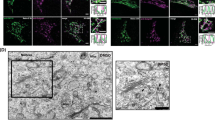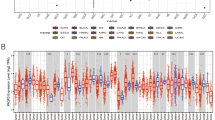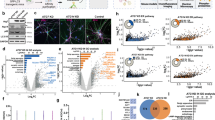Abstract
Ras plays a pivotal role in many cellular activities, and its subcellular compartmentalization provides spatial and temporal selectivity. Here we report a mode of spatial regulation of Ras signaling in the Golgi apparatus by two highly homologous proteins PAQR10 and PAQR11 of the progestin and AdipoQ receptors family. PAQR10 and PAQR11 are exclusively localized in the Golgi apparatus. Overexpression of PAQR10/PAQR11 stimulates basal and EGF-induced ERK phosphorylation and increases the expression of ERK target genes in a dose-dependent manner. Overexpression of PAQR10/PAQR11 markedly elevates Golgi localization of HRas, NRas and KRas4A, but not KRas4B. PAQR10 and PAQR11 can also interact with HRas, NRas and KRas4A, but not KRas4B. The increased Ras protein at the Golgi apparatus by overexpression of PAQR10/PAQR11 is in an active state. Consistently, knockdown of PAQR10 and PAQR11 reduces EGF-stimulated ERK phosphorylation and Ras activation at the Golgi apparatus. Intriguingly, PAQR10 and PAQR11 are able to interact with RasGRP1, a guanine nucleotide exchange protein of Ras, and increase Golgi localization of RasGRP1. The C1 domain of RasGRP1 is both necessary and sufficient for the interaction of RasGRP1 with PAQR10/PAQR11. The simulation of ERK phosphorylation by overexpressed PAQR10/PAQR11 is abrogated by downregulation of RasGRP1. Furthermore, differentiation of PC12 cells is significantly enhanced by overexpression of PAQR10/PAQR11. Collectively, this study uncovers a new paradigm of spatial regulation of Ras signaling in the Golgi apparatus by PAQR10 and PAQR11.
Similar content being viewed by others
Log in or create a free account to read this content
Gain free access to this article, as well as selected content from this journal and more on nature.com
or
References
Rodriguez-Viciana P, Sabatier C, McCormick F . Signaling specificity by Ras family GTPases is determined by the full spectrum of effectors they regulate. Mol Cell Biol 2004; 24:4943–4954.
Mor A, Philips MR . Compartmentalized Ras/MAPK signaling. Annu Rev Immunol 2006; 24:771–800.
Philips MR . Teaching resources. Imaging signal transduction in living cells with fluorescent proteins. Sci STKE 2005; 2005:tr28.
Choy E, Chiu VK, Silletti J, et al. Endomembrane trafficking of ras: the CAAX motif targets proteins to the ER and Golgi. Cell 1999; 98:69–80.
Jiang X, Sorkin A . Coordinated traffic of Grb2 and Ras during epidermal growth factor receptor endocytosis visualized in living cells. Mol Biol Cell 2002; 13:1522–1535.
Arozarena I, Matallanas D, Berciano MT, et al. Activation of H-Ras in the endoplasmic reticulum by the RasGRF family guanine nucleotide exchange factors. Mol Cell Biol 2004; 24:1516–1530.
Sobering AK, Romeo MJ, Vay HA, Levin DE . A novel Ras inhibitor, Eri1, engages yeast Ras at the endoplasmic reticulum. Mol Cell Biol 2003; 23:4983–4990.
Apolloni A, Prior IA, Lindsay M, Parton RG, Hancock JF . H-ras but not K-ras traffics to the plasma membrane through the exocytic pathway. Mol Cell Biol 2000; 20:2475–2487.
Chiu VK, Bivona T, Hach A, et al. Ras signalling on the endoplasmic reticulum and the Golgi. Nat Cell Biol 2002; 4:343–350.
Rebollo A, Perez-Sala D, Martinez AC . Bcl-2 differentially targets K-, N-, and H-Ras to mitochondria in IL-2 supplemented or deprived cells: implications in prevention of apoptosis. Oncogene 1999; 18:4930–4939.
Bivona TG, Quatela SE, Bodemann BO, et al. PKC regulates a farnesyl-electrostatic switch on K-Ras that promotes its association with Bcl-XL on mitochondria and induces apoptosis. Mol Cell 2006; 21:481–493.
Schaeffer HJ, Catling AD, Eblen ST, et al. MP1: a MEK binding partner that enhances enzymatic activation of the MAP kinase cascade. Science 1998; 281:1668–1671.
Teis D, Wunderlich W, Huber LA . Localization of the MP1-MAPK scaffold complex to endosomes is mediated by p14 and required for signal transduction. Dev Cell 2002; 3:803–814.
Luttrell LM, Roudabush FL, Choy EW, et al. Activation and targeting of extracellular signal-regulated kinases by beta-arrestin scaffolds. Proc Natl Acad Sci USA 2001; 98:2449–2454.
Caloca MJ, Zugaza JL, Bustelo XR . Exchange factors of the RasGRP family mediate Ras activation in the Golgi. J Biol Chem 2003; 278:33465–33473.
Bivona TG, Perez De Castro I, Ahearn IM, et al. Phospholipase Cgamma activates Ras on the Golgi apparatus by means of RasGRP1. Nature 2003; 424:694–698.
Rocks O, Peyker A, Bastiaens PI . Spatio-temporal segregation of Ras signals: one ship, three anchors, many harbors. Curr Opin Cell Biol 2006; 18:351–357.
Henis YI, Hancock JF, Prior IA . Ras acylation, compartmentalization and signaling nanoclusters. Mol Membr Biol 2009; 26:80–92.
Hancock JF, Paterson H, Marshall CJ . A polybasic domain or palmitoylation is required in addition to the CAAX motif to localize p21ras to the plasma membrane. Cell 1990; 63:133–139.
Rocks O, Peyker A, Kahms M, et al. An acylation cycle regulates localization and activity of palmitoylated Ras isoforms. Science 2005; 307:1746–1752.
Peyker A, Rocks O, Bastiaens PI . Imaging activation of two Ras isoforms simultaneously in a single cell. Chembiochem 2005; 6:78–85.
Tang YT, Hu T, Arterburn M, et al. PAQR proteins: a novel membrane receptor family defined by an ancient 7-transmembrane pass motif. J Mol Evol 2005; 61:372–380.
Feng L, Xie X, Ding Q, et al. Spatial regulation of Raf kinase signaling by RKTG. Proc Natl Acad Sci USA 2007; 104:14348–14353.
Fan F, Feng L, He J, et al. RKTG sequesters B-Raf to the Golgi apparatus and inhibits the proliferation and tumorigenicity of human malignant melanoma cells. Carcinogenesis 2008; 29:1157–1163.
Xie X, Zhang Y, Jiang Y, et al. Suppressive function of RKTG on chemical carcinogen-induced skin carcinogenesis in mouse. Carcinogenesis 2008; 29:1632–1638.
Yamauchi T, Kamon J, Ito Y, et al. Cloning of adiponectin receptors that mediate antidiabetic metabolic effects. Nature 2003; 423:762–769.
Luo XH, Guo LJ, Yuan LQ, et al. Adiponectin stimulates human osteoblasts proliferation and differentiation via the MAPK signaling pathway. Exp Cell Res 2005; 309:99–109.
Petridou ET, Mitsiades N, Gialamas S, et al. Circulating adiponectin levels and expression of adiponectin receptors in relation to lung cancer: two case-control studies. Oncology 2007; 73:261–269.
Arditi JD, Venihaki M, Karalis KP, Chrousos GP . Antiproliferative effect of adiponectin on MCF7 breast cancer cells: a potential hormonal link between obesity and cancer. Horm Metab Res 2007; 39:9–13.
Williams CJ, Mitsiades N, Sozopoulos E, et al. Adiponectin receptor expression is elevated in colorectal carcinomas but not in gastrointestinal stromal tumors. Endocr Relat Cancer 2008; 15:289–299.
Rehli M, Krause SW, Schwarzfischer L, Kreutz M, Andreesen R . Molecular cloning of a novel macrophage maturation-associated transcript encoding a protein with several potential transmembrane domains. Biochem Biophys Res Commun 1995; 217:661–667.
Wilde A, Reaves B, Banting G . Epitope mapping of two isoforms of a trans Golgi network specific integral membrane protein TGN38/41. FEBS Lett 1992; 313:235–238.
Bondeva T, Balla A, Varnai P, Balla T . Structural determinants of Ras-Raf interaction analyzed in live cells. Mol Biol Cell 2002; 13:2323–2333.
Shields JM, Pruitt K, McFall A, Shaub A, Der CJ . Understanding Ras: 'it ain't over 'til it's over'. Trends Cell Biol 2000; 10:147–154.
Mitin N, Rossman KL, Der CJ . Signaling interplay in Ras superfamily function. Curr Biol 2005; 15:R563–574.
Hancock JF, Cadwallader K, Paterson H, Marshall CJ . A CAAX or a CAAL motif and a second signal are sufficient for plasma membrane targeting of ras proteins. EMBO J 1991; 10:4033–4039.
Wright LP, Philips MR . Thematic review series: lipid posttranslational modifications. CAAX modification and membrane targeting of Ras. J Lipid Res 2006; 47:883–891.
Omerovic J, Laude AJ, Prior IA . Ras proteins: paradigms for compartmentalised and isoform-specific signalling. Cell Mol Life Sci 2007; 64:2575–2589.
Watanabe H, Grubb JH, Sly WS . The overexpressed human 46-kDa mannose 6-phosphate receptor mediates endocytosis and sorting of beta-glucuronidase. Proc Natl Acad Sci USA 1990; 87:8036–8040.
Frodin M, Gammeltoft S . Role and regulation of 90 kDa ribosomal S6 kinase (RSK) in signal transduction. Mol Cell Endocrinol 1999; 151:65–77.
Beaulieu N, Zahedi B, Goulding RE, et al. Regulation of RasGRP1 by B cell antigen receptor requires cooperativity between three domains controlling translocation to the plasma membrane. Mol Biol Cell 2007; 18:3156–3168.
Marshall CJ . Specificity of receptor tyrosine kinase signaling: transient versus sustained extracellular signal-regulated kinase activation. Cell 1995; 80:179–185.
Ebinu JO, Bottorff DA, Chan EY, et al. RasGRP, a Ras guanyl nucleotide- releasing protein with calcium- and diacylglycerol-binding motifs. Science 1998; 280:1082–1086.
Kawasaki H, Springett GM, Toki S, et al. A Rap guanine nucleotide exchange factor enriched highly in the basal ganglia. Proc Natl Acad Sci USA 1998; 95:13278–13283.
Quatela SE, Philips MR . Ras signaling on the Golgi. Curr Opin Cell Biol 2006; 18:162–167.
Ono Y, Fujii T, Igarashi K, et al. Phorbol ester binding to protein kinase C requires a cysteine-rich zinc-finger-like sequence. Proc Natl Acad Sci USA 1989; 86:4868–4871.
Wang H, Kazanietz MG . p23/Tmp21 differentially targets the Rac-GAP beta2-chimaerin and protein kinase C via their C1 domains. Mol Biol Cell 2010; 21:1398–1408.
Sun X, Han R, Wang Z, Chen Y . Regulation of adiponectin receptors in hepatocytes by the peroxisome proliferator-activated receptor-gamma agonist rosiglitazone. Diabetologia 2006; 49:1303–1310.
Oancea E, Meyer T . Protein kinase C as a molecular machine for decoding calcium and diacylglycerol signals. Cell 1998; 95:307–318.
Qin XF, An DS, Chen IS, Baltimore D . Inhibiting HIV-1 infection in human T cells by lentiviral-mediated delivery of small interfering RNA against CCR5. Proc Natl Acad Sci USA 2003; 100:183–188.
Ding Q, Jin T, Wang Z, Chen Y . Catalase potentiates retinoic acid-induced THP-1 monocyte differentiation into macrophage through inhibition of peroxisome proliferator-activated receptor gamma. J Leukoc Biol 2007; 81:1568–1576.
Acknowledgements
We thank Drs Natlie G Ahn (University of Colorado), Piero Crespo (Consejo Superior de Investigaciones Cientı´ficas), Xosé R Bustelo (University of Salamanca), Robert J Kay (University of British Columbia) and Juan S Bonifacino (National Institute of Child Health and Human Development) for generously providing the plasmids. This work was supported by research grants from Ministry of Science and Technology of China (2007CB947100 to YC and 2010CB529506 to YP and ZW), National Natural Science Foundation of China (30830037 and 81021002 to YC and 30971660 to YP), Chinese Academy of Sciences (KSCX2-EW-R-08 to YC), and Shanghai Institutes for Biological Sciences (2009KIP207 to YP).
Author information
Authors and Affiliations
Corresponding author
Additional information
(Supplementary information is linked to the online version of the paper on the Cell Research website.)
Supplementary information
Supplementary information, Figure S1
Hydrophobicity analysis of PAQR10 and PAQR11. (PDF 175 kb)
Supplementary information, Figure S2
Characterization of PAQR10/11 antibodies. (PDF 474 kb)
Supplementary information, Figure S3
PAQR10 but not AdipoR2 can activate ERK signaling. (PDF 90 kb)
Supplementary information, Figure S4
A Golgi-specific protein TGN38 does not affect ERK signaling. (PDF 120 kb)
Supplementary information, Figure S5
PAQR10-mediated stimulation of Egr-1 gene expression is inhibited by GFP-RBD and MEK inhibitor PD98059. (PDF 93 kb)
Supplementary information, Figure S6
Control experiments for confocal studies. (PDF 100 kb)
Supplementary information, Figure S7
PAQR10 increases Golgi localization of HRas, NRas, KRas4A but no KRas4B in the Golgi apparatus in MDCK cells. (PDF 136 kb)
Supplementary information, Figure S8
The distribution of HRas on the plasma membrane and Golgi apparatus is affected by PAQR10/PAQR11 overexpression. (PDF 65 kb)
Supplementary information, Figure S9
Interaction of PAQR10/PAQR11 with HRas, NRas and KRas4A. (PDF 395 kb)
Supplementary information, Figure S10
Analysis of PAQR10/PAQR11 siRNA efficiency. (PDF 236 kb)
Supplementary information, Figure S11
Analysis of RasGRP1 siRNA efficiency. (PDF 62 kb)
Supplementary information, Figure S12
Silencing of RasGRP1 affects activation of Ras in the Golgi apparatus by PAQR10/PAQR11 overexpression. (PDF 347 kb)
Supplementary information, Figure S13
Knockdown of RasGRP1 does not affect PAQR10/PAQR11-induced Golgi localization of HRas and the interaction between HRas and PAQR10/PAQR11. (PDF 171 kb)
Supplementary information, Figure S14
EGF treatment has no effect on the expression of PAQR10 and PAQR11. (PDF 284 kb)
Rights and permissions
About this article
Cite this article
Jin, T., Ding, Q., Huang, H. et al. PAQR10 and PAQR11 mediate Ras signaling in the Golgi apparatus. Cell Res 22, 661–676 (2012). https://doi.org/10.1038/cr.2011.161
Received:
Revised:
Accepted:
Published:
Issue date:
DOI: https://doi.org/10.1038/cr.2011.161
Keywords
This article is cited by
-
Targeting the RAS/RAF/MAPK pathway for cancer therapy: from mechanism to clinical studies
Signal Transduction and Targeted Therapy (2023)
-
Dissection of mendelian predisposition and complex genetic architecture of craniovertebral junction malformation
Human Genetics (2023)
-
Accessory proteins of the RAS-MAPK pathway: moving from the side line to the front line
Communications Biology (2021)
-
UBIAD1 suppresses the proliferation of bladder carcinoma cells by regulating H-Ras intracellular trafficking via interaction with the C-terminal domain of H-Ras
Cell Death & Disease (2018)
-
Characterization of Golgi scaffold proteins and their roles in compartmentalizing cell signaling
Journal of Molecular Histology (2014)



